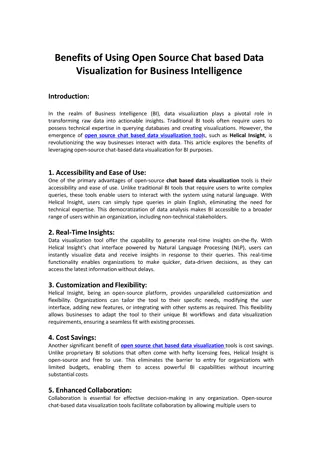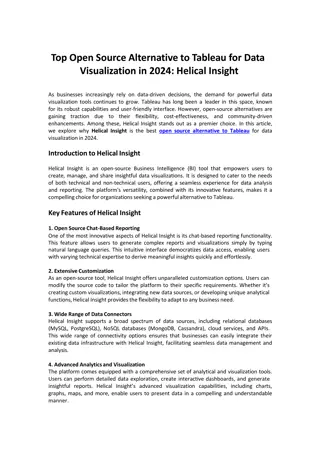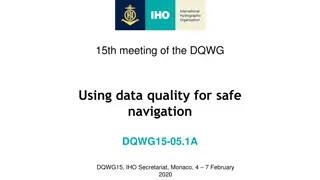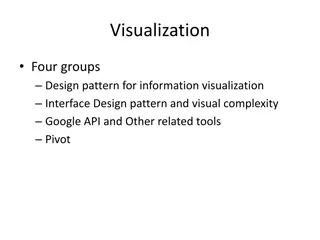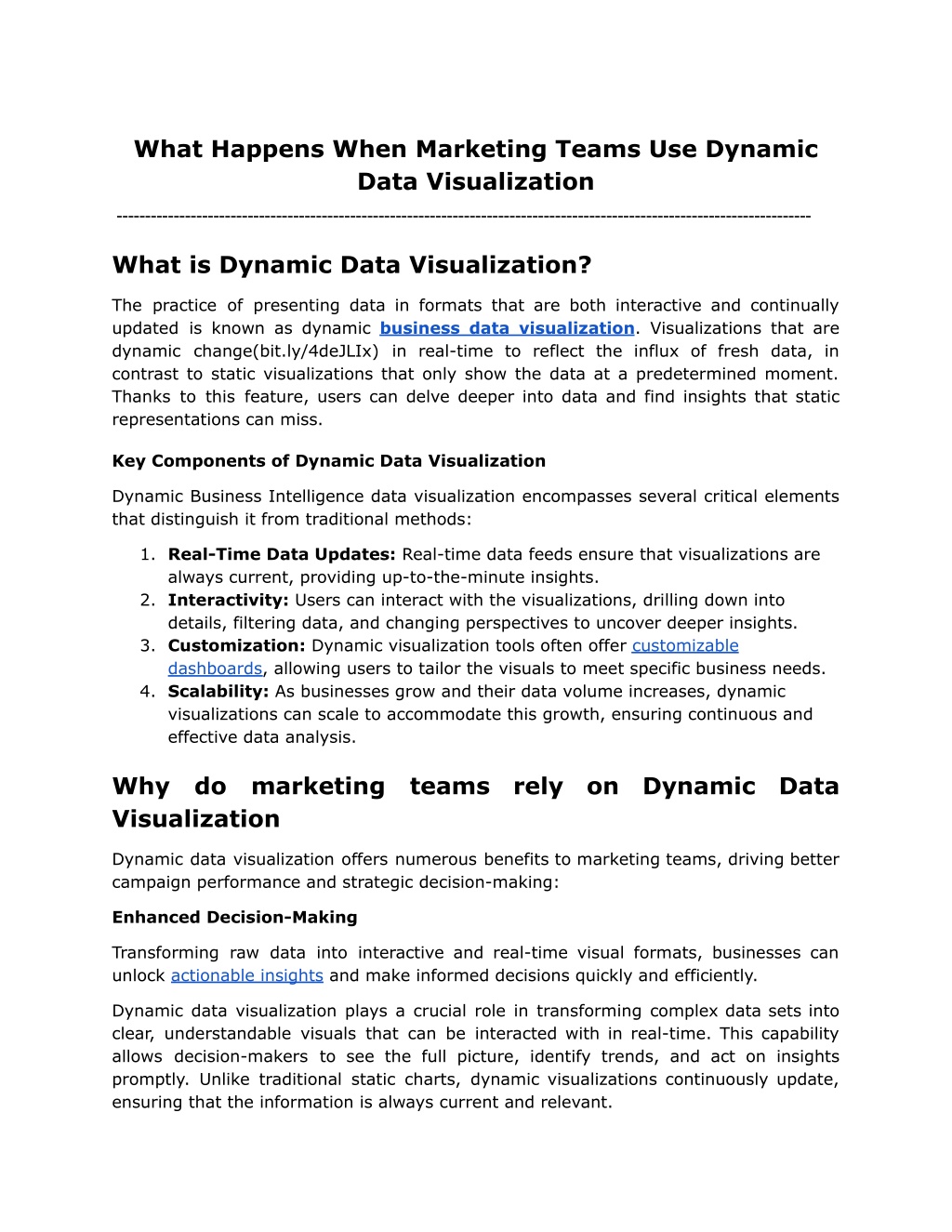
What Happens When Marketing Teams Use Dynamic Data Visualization
Many businesses are relying on the art of dynamic business data visualization for their marketing campaigns. Find out how marketing teams can maximize campaign success, get access to granular customer insights, and enable an informed decision-making
Download Presentation

Please find below an Image/Link to download the presentation.
The content on the website is provided AS IS for your information and personal use only. It may not be sold, licensed, or shared on other websites without obtaining consent from the author. Download presentation by click this link. If you encounter any issues during the download, it is possible that the publisher has removed the file from their server.
E N D
Presentation Transcript
What Happens When Marketing Teams Use Dynamic Data Visualization -------------------------------------------------------------------------------------------------------------------------- What is Dynamic Data Visualization? The practice of presenting data in formats that are both interactive and continually updated is known as dynamic business data visualization. Visualizations that are dynamic change(bit.ly/4deJLIx) in real-time to reflect the influx of fresh data, in contrast to static visualizations that only show the data at a predetermined moment. Thanks to this feature, users can delve deeper into data and find insights that static representations can miss. Key Components of Dynamic Data Visualization Dynamic Business Intelligence data visualization encompasses several critical elements that distinguish it from traditional methods: 1. Real-Time Data Updates: Real-time data feeds ensure that visualizations are always current, providing up-to-the-minute insights. 2. Interactivity: Users can interact with the visualizations, drilling down into details, filtering data, and changing perspectives to uncover deeper insights. 3. Customization: Dynamic visualization tools often offer customizable dashboards, allowing users to tailor the visuals to meet specific business needs. 4. Scalability: As businesses grow and their data volume increases, dynamic visualizations can scale to accommodate this growth, ensuring continuous and effective data analysis. Why Visualization do marketing teams rely on Dynamic Data Dynamic data visualization offers numerous benefits to marketing teams, driving better campaign performance and strategic decision-making: Enhanced Decision-Making Transforming raw data into interactive and real-time visual formats, businesses can unlock actionable insights and make informed decisions quickly and efficiently. Dynamic data visualization plays a crucial role in transforming complex data sets into clear, understandable visuals that can be interacted with in real-time. This capability allows decision-makers to see the full picture, identify trends, and act on insights promptly. Unlike traditional static charts, dynamic visualizations continuously update, ensuring that the information is always current and relevant.
One of its primary benefits is its ability to provide real-time insights. This immediacy helps in our fast-paced business environment, where timely decisions can significantly impact outcomes. With real-time data, marketing teams can monitor campaigns as they unfold, adjust strategies on the fly, and respond to emerging trends without delay. Taking an example, a marketing team using business data visualization tools can track customer engagement metrics in real-time. If a campaign is underperforming, they can quickly identify the issue, adjust their approach, and improve results. This agility is made possible by the interactive nature of dynamic visualizations, which allow users to drill down into data, filter results, and view metrics from different perspectives. Effective different departments. Dynamic Business Intelligence data visualization tools foster this by providing a shared platform where teams can view and interact with the same data. This transparency ensures that everyone is on the same page and can contribute to informed decision-making. decision-making often requires collaboration and communication across For instance, a marketing team can share their dynamic dashboards with the sales and product development teams. This collaboration allows sales to adjust their pitches based on current marketing performance and customer feedback, while product development can prioritize features that resonate most with customers. The result is a more cohesive and aligned strategy that drives business success. Improved Campaign Performance One of the most significant advantages of dynamic data visualization is the ability to monitor campaigns in real-time. Business data visualization tools allow marketing teams to track key performance indicators conversion rates, and customer engagement as they happen. This real-time insight enables teams to adjust their strategies on the fly, ensuring that campaigns remain effective throughout their duration. (KPIs) such as click-through rates, For instance, a marketing team using BI software can set up dashboards that display real-time data from various channels, such as social media, email, and paid advertising. If a particular ad is underperforming, the team can quickly identify the issue and make necessary adjustments, such as changing the ad copy or targeting different audience segments. This agility ensures that marketing efforts are always optimized for maximum impact. With no-code data visualization tools, marketing teams can easily create interactive dashboards that compare the performance of different ads, emails, or landing pages side by side. This comparison helps teams quickly determine which version resonates best with their audience. It s called A/B testing. Learn: Why Every Marketer Should Be A/B Testing Their Dashboards for Conversion Optimization
Taking an example of a team might test two versions of an email campaign to see which one generates more conversions. By visualizing the results in real-time, they can identify the winning version early in the process and allocate more resources to it, thereby maximizing the overall campaign performance. Better Customer Understanding Visualizing data from various sources, companies can identify distinct customer groups based on behavior, demographics, and preferences. It can lead to a manner of segmentation that s suited for more targeted and personalized marketing efforts. Business data visualization tools allow companies to track customer interactions and
behaviors as they happen, offering a current and accurate picture of customer activities. Personalization is a critical aspect of modern marketing, and dynamic Business Intelligence data visualization provides the insights needed to achieve it. By analyzing customer data visually, businesses can identify individual preferences and tailor their communications and offerings accordingly. Mapping the customer journey is essential for understanding how customers interact with a business across various touchpoints. Dynamic data visualization enables companies to create detailed and interactive customer journey maps that highlight key interactions and pain points. A travel agency, for example, can use BI software to visualize the customer journey from initial inquiry to booking and post-travel feedback. By identifying where customers drop off or face challenges, the agency can make targeted improvements to the customer experience, leading to higher satisfaction and loyalty. You can also visualize customer feedback data; businesses can identify common themes, track sentiment, and prioritize areas for improvement. Collaborative Insights Decision-making often involves multiple departments and stakeholders. Collaborative insights allow teams to work together more effectively, combining their expertise to interpret data and derive actionable strategies. Business data visualization tools are essential in this process, as they provide a common platform for viewing and analyzing data. Taking dynamic data visualization in full stride, better communication within and between teams is easily within reach. Data visualizations, as opposed to raw figures or text-based reports, are frequently more conducive to discussion and comprehension. By visualizing data, teams can quickly grasp complex information, identify trends, and communicate findings more effectively. When teams regularly use BI software to analyze and share data, it reinforces the importance of data in decision-making processes. This cultural shift leads to more objective, evidence-based strategies and reduces reliance on intuition or guesswork. Conclusion Dynamic data visualization transforms how marketing teams operate, making them more agile, data-driven, and effective. By providing real-time insights, enhancing decision-making, improving campaign performance, and fostering collaborative insights, dynamic data visualization empowers marketing teams to achieve superior results. The ability to interact with and customize data visualizations enables teams to uncover deep insights, optimize strategies on the fly, and better understand their customers.
For marketing teams looking to leverage the power of dynamic data visualization, Grow offers robust BI software that supports no-code data visualization, making it accessible to everyone. Grow's platform allows you to create interactive, real-time dashboards that integrate seamlessly with your existing data sources, providing a unified view of your marketing performance. Ready to see the difference for yourself? Start your journey to better marketing insights with a 14-day free trial of Grow. Explore how Grow s dynamic data dashboards can transform your marketing strategies and drive better business outcomes. Want to hear what others are saying about Grow? Check out the reviews on the Grow data dashboard Trustradius and see why businesses trust Grow for their data visualization needs. Enhance your marketing efforts with Grow and unlock the full potential of your data. Original Source: https://bit.ly/3yiQHVY







